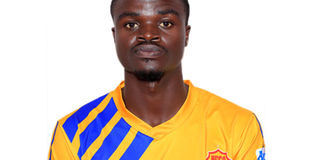Nunda: My injuries at KCCA due to art-turf

gBumps. Injures have hampered Nunda’s career. PHOTO | KCCA FC
What you need to know:
Earlier this month, KCCA physio Ivan Ssewanyana told this paper that he was undertaking research on the spate of injuries at Lugogo, focusing on the possibility that art turf was responsible for most of it.
However, other sports scientists believe there is more to it, citing training methods, players’ ignorance on how to play on different surfaces, as well as psychological pressures.
Two moments highlight Jackson Nunda’s five-year stay at KCCA. In April 2016 at Nakivubo, Nigerian legend Nwankwo Kanu endorsed his exceptional talent after he had put Villa to the sword in the StarTimes Cup.
In September 2017, the lanky attacking midfielder rewound the clock to the days of Jackson Mayanja and Jamil Kyambadde when he netted a collector’s item against Onduparaka at Lugogo.
From then on Nunda has been hailed as a unique talent even when his promising career has been blighted by injuries. KCCA shut the door on him last week. “I’m grateful for the time, exposure, opportunities and the trophies I’ve won in my five years Iat KCCA,” the silky left-footer said.
“But it hurts that I’ve not made 80 games in the five years. My doctors and I believe the artificial turf has partly been responsible for the spate of injuries I’ve been nursing.”
Nunda’s skills and ability to read the game suggested he could become a special player for Uganda Cranes and paid ranks but his body has been letting him down since suffering a meniscus injury that was first operated on in 2016.
The meniscus injury comes with knee pain, swelling, popping, and feeling of the knee ‘giving way.’ Doctor warns on turf Nunda is yet to play for any national team outfit and made only eight appearances for KCCA last season.
Dr Vincent Patrick Karuhanga, a physician at Friends Polyclinic, said art turf surfaces have been used less in most countries for the many dangers that come with them.
“The [meniscus] injury affects a cap-like area on the shin bone that stabilises the knee. It usually happens with hard contact to the knee, collision, and freak injury,” he said.
“Art-turf is not recommended for athletes and that is why they don’t play football on cement. Football should be played on natural grass because joints move while the players are in action.”
KCCA’s routine training regime includes exercises, morning and afternoon ball work, almost daily practice matches between Kirunda and Omondi select sides.
Earlier this month, KCCA physio Ivan Ssewanyana told this paper that he was undertaking research on the spate of injuries at Lugogo, focusing on the possibility that art turf was responsible for most of it.
However, other sports scientists believe there is more to it, citing training methods, players’ ignorance on how to play on different surfaces, as well as psychological pressures.




